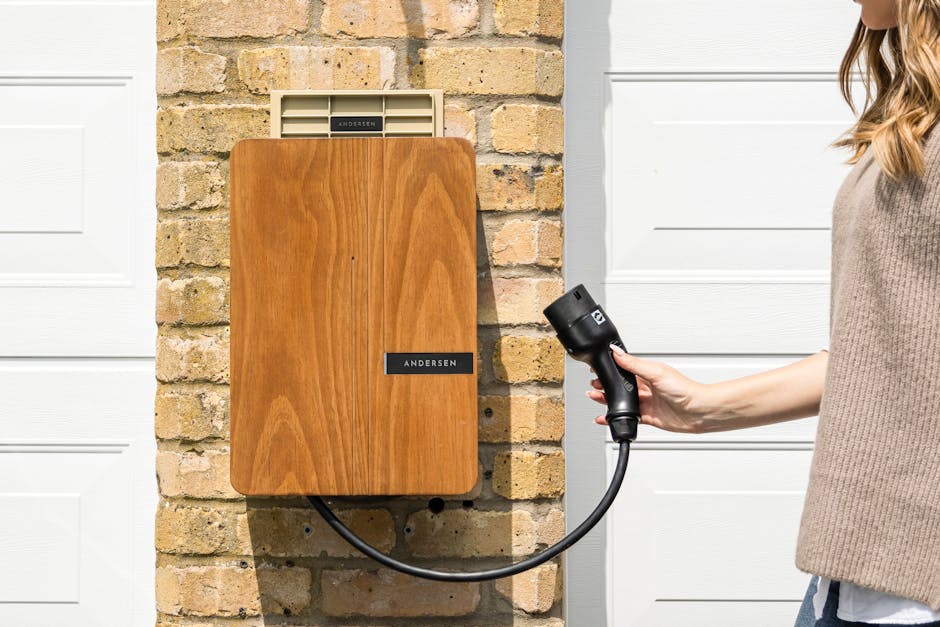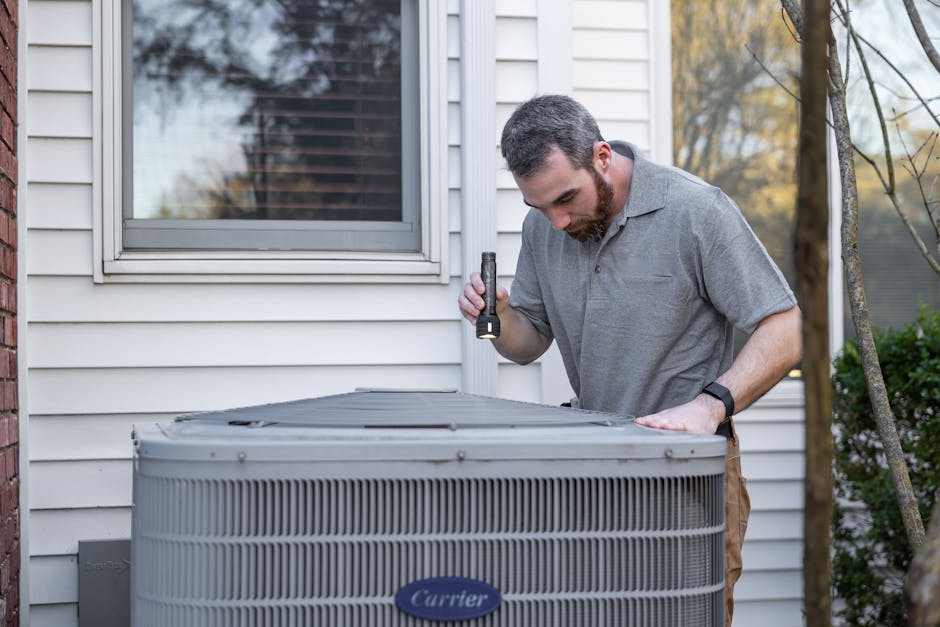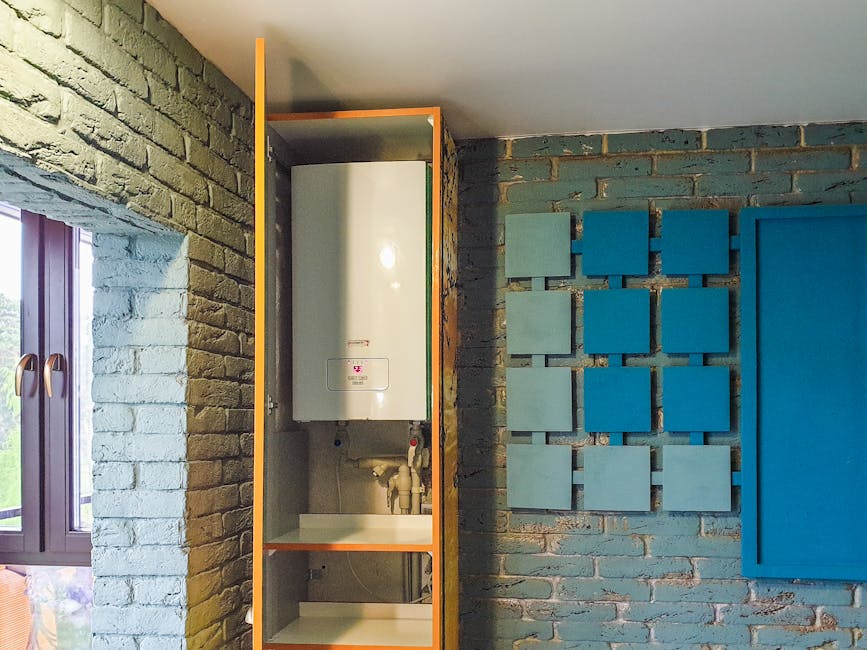Why Your Home's Electrical Panel is the Heart of Safety and Power
Electrical panel installation is a critical home upgrade that ensures your electrical system can safely handle modern power demands while protecting your family from electrical hazards. Your electrical panel - also called a breaker box - serves as the main distribution point for electricity coming into your home, controlling power flow to every outlet, switch, and appliance through individual circuit breakers.
Key aspects of electrical panel installation:
- Professional installation required - Never attempt as DIY due to high voltage dangers
- Average cost range - $2,500-$5,000 for most residential upgrades
- Timeline - 1-2 days for installation plus permit and inspection time
- Common upgrade - 100-amp to 200-amp service for modern homes
- Safety benefits - AFCI/GFCI breaker protection and proper grounding
Most homes built over 15 years ago have panels that struggle with today's electrical demands. Frequent breaker trips, flickering lights, or insurance company concerns about your panel's age are clear signs an upgrade is needed.
Modern electrical panels do more than just distribute power - they actively protect your home. Circuit breakers quickly shut off power during overloads or faults, while specialized AFCI breakers detect dangerous electrical arcs that could cause fires, and GFCI breakers protect against electrocution in wet areas.
I'm Mike Townsend, and my eight years in the U.S. Army managing precision cooling systems for heat-seeking missiles taught me that electrical panel installation demands absolute attention to detail and safety. At Veteran Heating, Cooling, Plumbing & Electric, we bring military-grade precision to every installation, ensuring your family's safety and your home's electrical reliability.
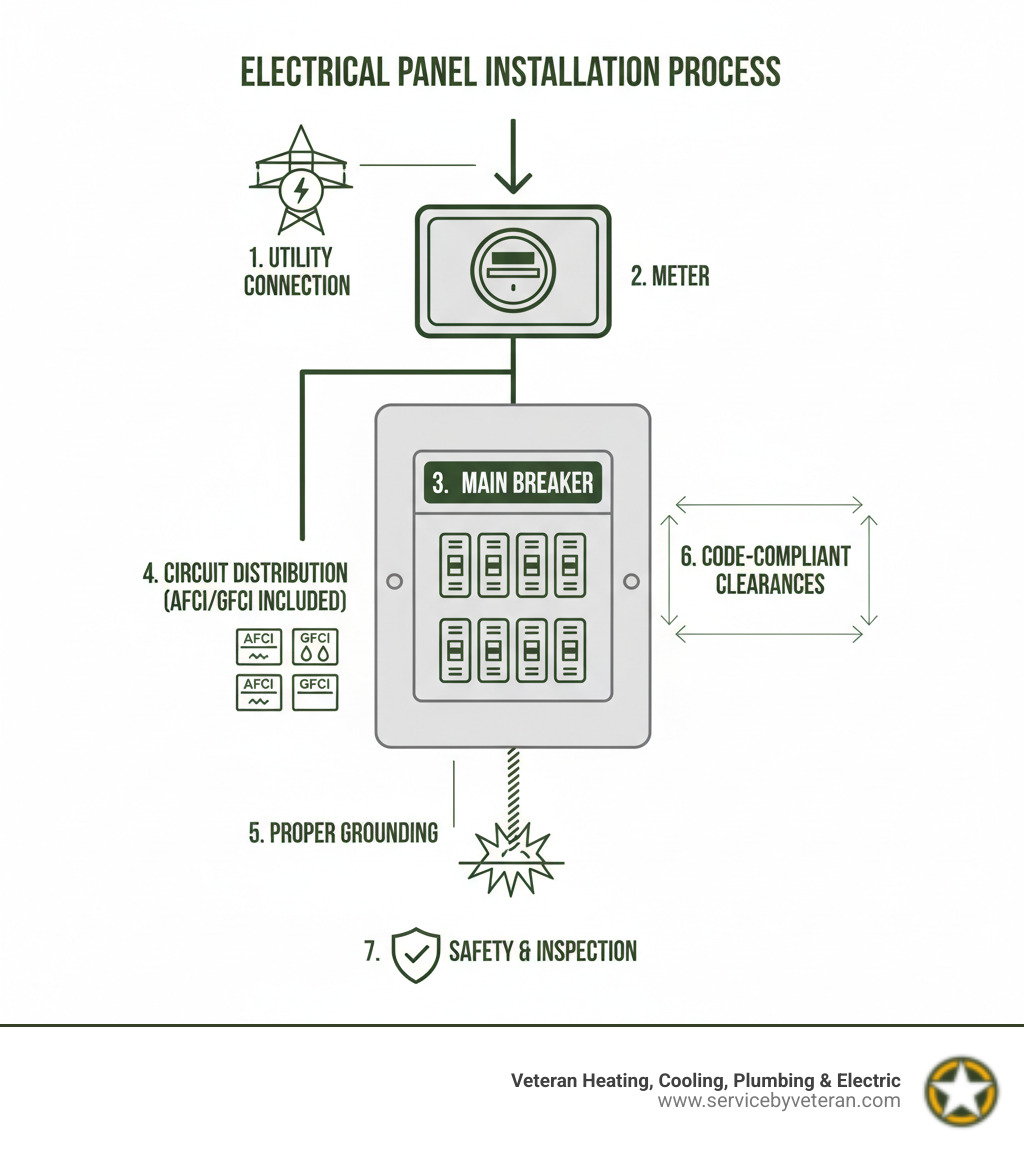
Understanding Your Electrical System: When and Why to Upgrade
Your home's electrical panel is the quarterback of your electrical system, distributing power and protecting everything. But panels can age or get overwhelmed by modern demands.
Located in a basement, garage, or closet, your electrical panel takes the main power line from your utility company and divides it into circuits for everything from your coffee maker to gaming systems.
Many panels over 15-20 years old struggle with modern lifestyles, as they weren't designed for today's EV chargers, smart homes, and numerous electronics.
Signs You Need an Upgrade or Replacement
Your electrical panel has ways of telling you it's overwhelmed. Recognizing these signs can save you from bigger problems.
Flickering or dimming lights when major appliances turn on is a clear sign your system is struggling with the load.
Frequent breaker trips are a red flag. While breakers are designed to trip during overloads, constant resetting suggests your panel is undersized.
Any burning smell or scorched outlets is a safety emergency that requires immediate professional attention.
Strange buzzing or crackling sounds from your panel indicate dangerous issues like loose connections. Panels should be silent, so any noise is a cause for concern.
If your panel cover feels warm or hot to the touch, that's not normal. This can signal dangerous overloading or faulty wiring that needs immediate professional evaluation.
If you still have a fuse box instead of circuit breakers, it should be upgraded. Fuse boxes offer less protection and convenience than modern breaker panels and don't meet current safety standards.
Age matters - panels over 15-20 years old often don't meet current codes and struggle with modern demands. Many insurance companies require upgrades due to the safety risks of outdated systems.
Planning to add major new appliances like central AC, an electric vehicle charger, or a hot tub often requires more capacity than older panels can provide.
"Doubled-up" circuits, with multiple circuits on one breaker, are a dangerous sign of an overloaded panel needing professional attention.
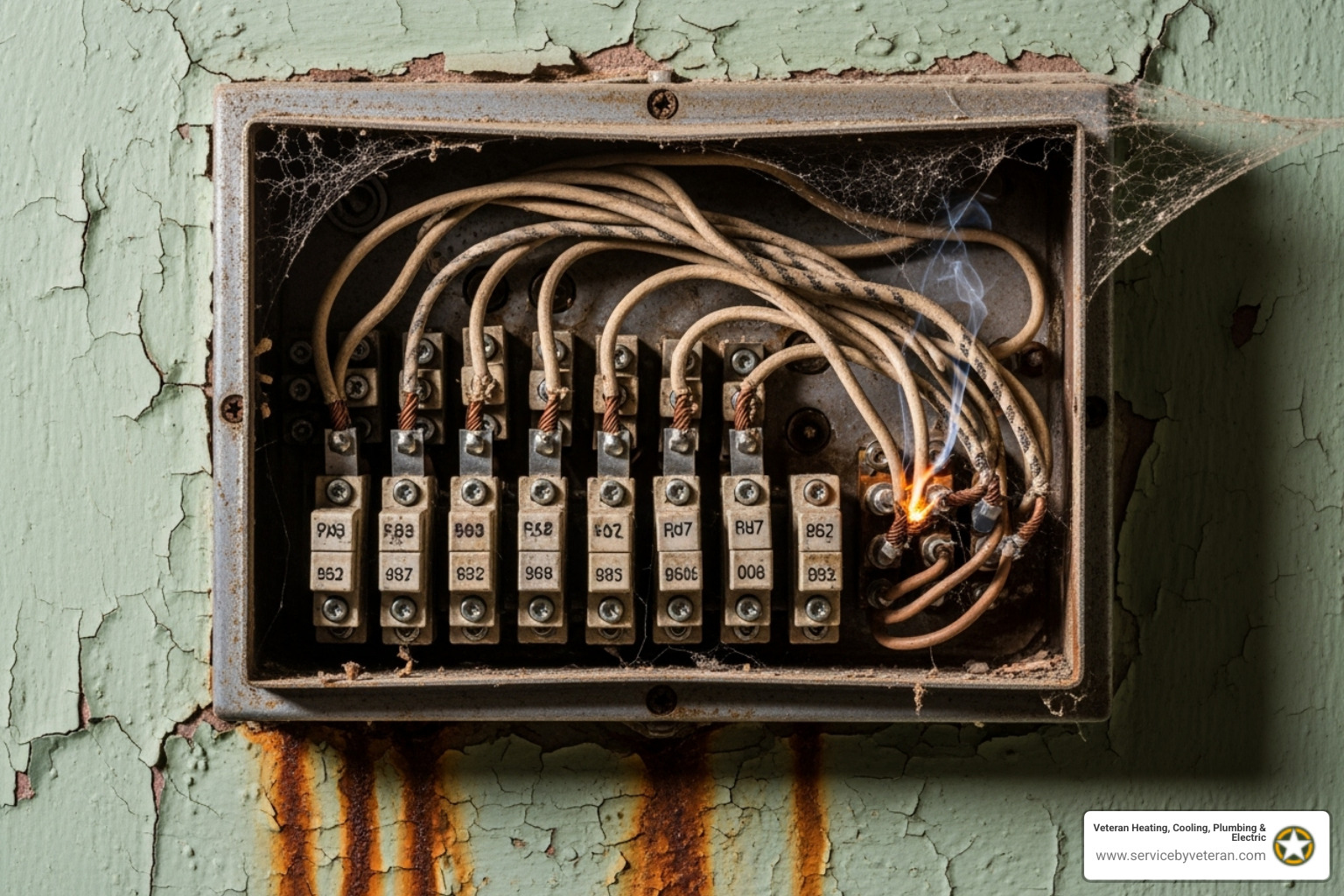
Signs of an outdated electrical panel, like a fuse box, indicate a clear need for an upgrade.
Panels come in different sizes. 100-amp panels, once standard, are often insufficient for today's demands, leading to frequent trips and safety concerns.
200-amp panels are ideal for most modern homes, providing ample power with room for future expansion.
400-amp panels serve larger homes with extensive electrical needs, such as multiple HVAC systems, workshops, or several EV chargers.
You'll also encounter surface-mount panels (mounted on the wall) and flush-mount panels (recessed into the wall). Flush-mounts are more complex and costly due to wall modifications but offer a cleaner look.
For comprehensive electrical system evaluation and upgrades, explore our Electrical Installation Service.
Benefits of a 200-Amp Panel Upgrade
Upgrading to a 200-amp panel offers benefits far beyond just more power.
Increased capacity lets you run multiple appliances simultaneously. A 200-amp panel comfortably handles power-hungry devices like EV chargers and modern HVAC systems.
Improved safety comes from advanced technology like AFCI breakers, which prevent fires from electrical arcs, and GFCI protection, which guards against electrocution. These are essential safety upgrades.
Your home's value increases with a modern electrical panel. Buyers see it as a sign of a reliable, safe electrical system, making it a great investment.
Future-proofing your home is a major benefit. A 200-amp panel ensures you're ready for advancing technology like solar panels or new smart home systems. As research shows, outdated residential electrical panels create significant barriers to home electrification, making upgrades crucial for modern living.
Key Components of Your Electrical Panel
Understanding your panel's components helps you appreciate the system protecting your home.
The main breaker is the master switch for your home's electricity, serving as the emergency shutoff and determining your home's total electrical capacity.
Circuit breakers protect individual circuits. Standard breakers offer basic overload protection, while specialized breakers add safety features.
Arc-Fault Circuit Interrupters (AFCI) detect dangerous arcs that can cause fires. Codes require them in living spaces to prevent electrical fires.
Ground-Fault Circuit Interrupters (GFCI) prevent electric shock by instantly shutting off power when they detect imbalances. They are used in wet areas like kitchens, bathrooms, and outdoors.
Bus bars are metal strips that distribute current. The neutral bar connects neutral wires, and the grounding connection provides a safe path for fault currents.
Service entrance wires are the heavy-duty cables bringing electricity from your utility meter to the main breaker.
These components work together to ensure safe, reliable power, making modern electrical panel installation a blend of engineering and safety.
The Professional Electrical Panel Installation Process
When it comes to electrical panel installation, this is absolutely not a DIY project. Working with high-voltage electricity requires specialized knowledge, proper tools, and years of training. One mistake could result in electrocution, house fires, or code violations that void your insurance.
At Veteran Heating, Cooling, Plumbing & Electric, we've developed a systematic approach to electrical panel installation that prioritizes safety above everything else. Our veteran electricians bring the same attention to detail and precision we learned in military service to every installation.
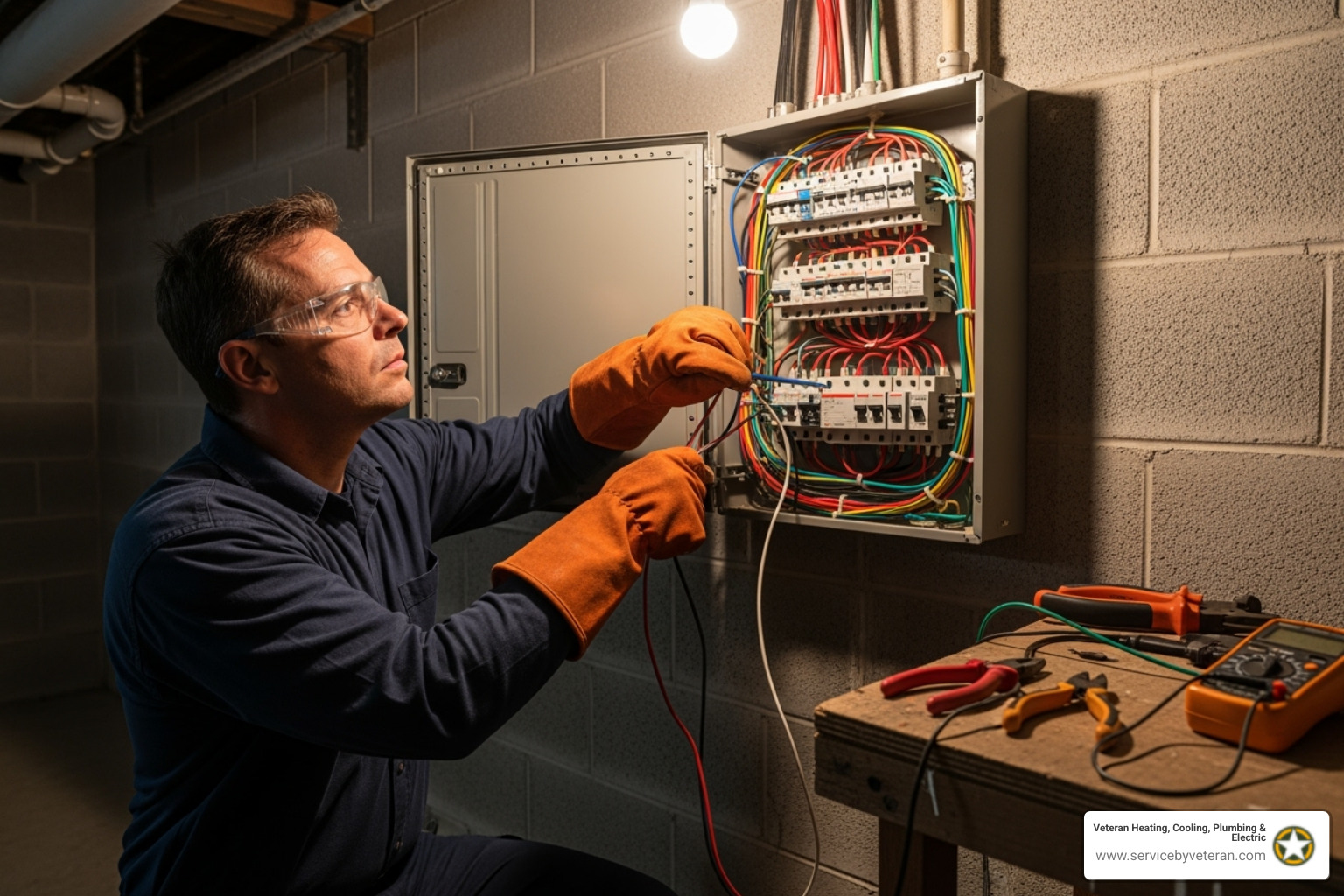
A licensed electrician safely working on an open electrical panel with proper safety gear.
Step-by-Step Electrical Panel Installation
The electrical panel installation process is methodical and precise.
Planning and permits come first. We assess your current and future electrical needs to select the right panel, then handle all permit paperwork with your local municipality. Permits are essential for code compliance and typically cost between $50 and $500 in areas like Denver, Lakewood, or Castle Rock.
Power disconnection is a critical safety step. We coordinate with your utility company (like Xcel Energy in Colorado) to safely disconnect power to your home. This is not a DIY step, and you should plan to be without power for a full day.
After confirming the power is off with voltage testers, we begin old panel removal. We carefully label each wire before disconnecting it and removing the old panel, which requires patience and expertise.
New panel mounting requires precision. The panel must be level and positioned to meet strict code clearances. Flush-mount installations look cleaner but require more wall preparation and may involve stucco repair.
Wiring and connections are the heart of the installation. We connect the main service entrance wires and then each circuit to the correct bus bars. All connections must be tight to prevent dangerous arcing and fires.
Breaker installation involves snapping each breaker into place. We install standard, AFCI, and GFCI breakers, each with specific wiring requirements for proper function, especially the specialized AFCI and GFCI units.
Labeling and final inspection complete the process. Every circuit is clearly labeled on the panel door. After our internal check, a municipal inspector verifies the work is code-compliant before the utility restores power.
Key Safety Considerations for an Electrical Panel Installation
Safety is paramount in electrical panel installation. Hiring a licensed electrician is your most important decision. Our veteran electricians have the training, experience, and insurance to do the job safely.
Adhering to safety codes is critical. These national and local rules prevent fires, electrocution, and property damage, dictating everything from wire size to panel placement.
Our electricians use proper personal protective equipment, like insulated gloves and safety glasses, and specialized, rated tools. We always use voltage testers to confirm power is off before starting work, as assumptions can be fatal.
A Guide to Proper Wiring and Code Requirements
Proper wiring in electrical panel installation is non-negotiable.
Service entrance cable must be sized correctly for your service. A 100-amp service needs #4 AWG copper wire, while 200-amp service requires #2/0 AWG copper. Incorrect sizing is unsafe.
Conduit use is necessary when cables are exposed or pass through concrete. We use correctly sized conduit (e.g., 1-1/4" for 100-amp, 2" for 200-amp) and seal entries to prevent moisture.
Grounding wire installation provides a critical safety path during a fault. Wire size depends on the service (#6 AWG copper for 100-amp, #4 AWG for 200-amp). It connects to grounding rods driven into the ground, with exposed sections protected by conduit.
Bonding connects all metal electrical components to prevent dangerous voltage differences and shock hazards between your panel, conduits, and water pipes.
Code requirements for safe clearances specify panel placement and the clear space required. The main breaker can't be more than 5'7" high, with at least 3'3" of clear space in front and 6" to each side. Panels must be in dry, accessible locations—never bathrooms or closets—for safe operation and emergency access.
Circuit labeling is required by code for safety. A clearly labeled panel is crucial for homeowners, emergency responders, and future electricians to work safely on your system. For detailed guidance on this important step, check out this Step-by-Step Guide to labeling your electrical panel.
Budgeting for Your Upgrade: Costs, Timelines, and Permits
Electrical panel installation is a significant investment. Understanding the costs helps you budget and avoid surprises.
A typical electrical panel installation ranges from $2,500 to $5,000 for most homes, but the final price depends on several key factors.
Panel size is the biggest cost factor. A 100-amp to 200-amp upgrade typically costs $1,800 to $2,200. A 400-amp service can cost $3,500 to $5,000 or more. A same-size replacement is less expensive, around $1,500 to $2,500.
Labor costs are a significant part of the investment. A 200-amp installation takes 8 to 10 hours of skilled labor from licensed electricians, costing $900 to $1,300. Complex wiring or difficult access can add 1 to 4 hours.
Additional wiring needs can add to the cost. New circuits or fixing outdated wiring can cost $500 to $2,000. Grounding upgrades and surge protection add $300 to $1,000 and are often necessary for safety and code compliance.
The type of installation also affects your budget. Surface-mount panels are less expensive. Flush-mount installations look cleaner but require wall modifications, increasing cost and time.
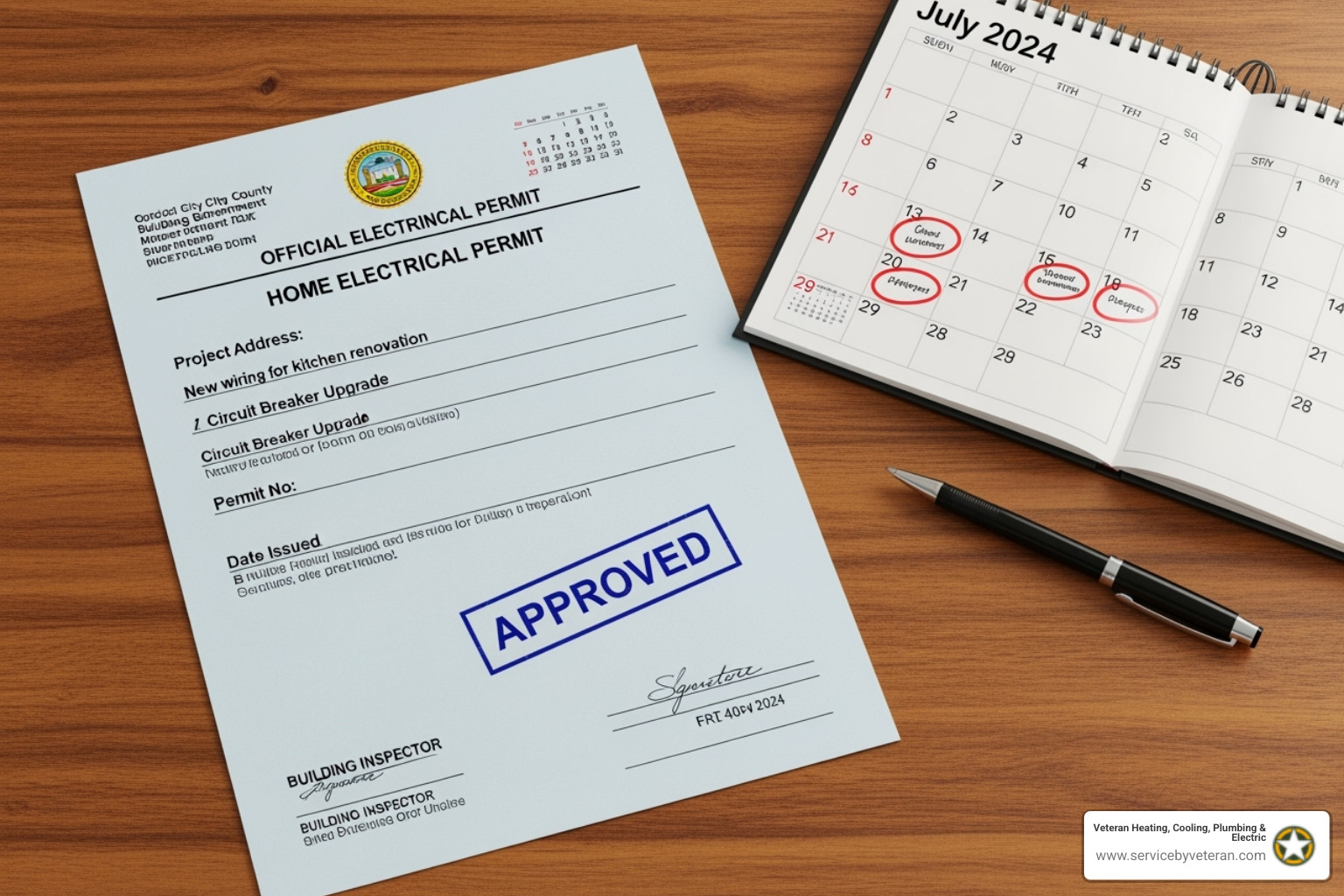
Permits and planning are crucial steps in any electrical panel installation.
Remember to budget for other costs. Permit fees range from $50 to $500 depending on your city (e.g., Denver, Lakewood, Castle Rock). Utility fees for power shut-off/reconnection are about $400. It's wise to budget at least $500 extra for unforeseen issues.
Timeline planning is also key. The installation takes 1 to 2 days, but the full process is longer. Allow time for permits (2-14 business days), utility scheduling (3-4 weeks), and final inspections (1-10 days).
To save money without cutting corners, get at least three quotes from licensed electricians. You can also combine the panel upgrade with other electrical work and clear the work area beforehand to reduce labor time.
Right-sizing your panel saves money long-term. Installing a slightly larger panel than you currently need prevents costly future upgrades.
Breaking Down the Cost of an Electrical Panel Installation
Here's where your money actually goes in a typical electrical panel installation:
Electrical panel installation is a significant investment in safety, capacity, and home value. We offer flexible financing options to help manage the cost, and our maintenance plans keep your new system running smoothly for years to come.
Don't choose the lowest bidder. Your family's safety depends on quality work from licensed professionals who understand technical requirements and local codes. Saving a few hundred dollars isn't worth the risk of poor workmanship or code violations.
Frequently Asked Questions about Electrical Panel Installation
Can I perform a DIY electrical panel installation?
Absolutely not. I can't stress this enough - electrical panel installation is never a DIY project. The dangers are too great, and the risks far outweigh any potential savings.
Here's why you should never attempt this yourself:
- You're working with high-voltage electricity that can cause severe injury, cardiac arrest, or fatal shock. Even experienced electricians take extensive safety precautions.
- DIY electrical work creates fire hazards. Improper connections, incorrect wire sizing, or faulty grounding can cause electrical arcs and overheating that lead to house fires.
- There are also legal and financial consequences. DIY installations violate local codes, which can void your homeowner's insurance and create major problems when you sell your home. Insurers may refuse to cover damage from unpermitted work.
- Modern electrical systems require specialized knowledge of codes and safety protocols that can't be learned from a video. Licensed electricians spend years in training.
What is the difference between upgrading a panel and rewiring a house?
These are two different projects, and understanding the distinction helps you know what your home needs.
An electrical panel upgrade involves replacing your main breaker box. This could be to increase capacity (e.g., from 100 to 200 amps) or replace an aging panel. The home's existing wiring typically stays in place.
House rewiring, on the other hand, is more extensive, involving the replacement of all the electrical wiring in your home. It's often necessary for older homes with outdated or dangerous wiring like knob-and-tube or aluminum.
A panel upgrade is often part of a full rewire, but a rewire isn't always needed for a panel upgrade. Many homes just need a new panel to handle modern demands, while the existing wiring is still safe.
The good news is that most panel upgrades don't require a full rewire. Our team can perform an electrical inspection to determine the best approach for your home.
How long does a new electrical panel last?
A properly installed electrical panel is built to last 25 to 40 years under normal conditions, providing decades of reliable service.
However, individual components may need attention sooner. Circuit breakers can wear out from frequent tripping or age, typically needing replacement every 15-20 years. Replacing individual breakers is much less expensive than a full panel replacement.
Several factors can affect your panel's lifespan, including consistent overloading, moisture exposure that causes corrosion, and physical damage.
You might need an upgrade before your panel reaches its end of life to meet increased electrical demands from EV chargers or smart homes. Updated safety codes may also require newer protection features that older panels lack.
The key to maximizing your panel's lifespan is regular maintenance and professional inspections. Our electricians can spot potential issues early to keep your system running safely for its full expected life.
Conclusion
Your home's electrical panel installation represents one of the smartest investments you can make for your family's safety and your property's future. This isn't just another home improvement project - it's the foundation that keeps your lights on, your appliances running safely, and your family protected from electrical hazards.
Think about everything we've covered: improved safety through advanced AFCI and GFCI breakers that prevent fires and electrocution, increased capacity to handle modern appliances like EV chargers and smart home systems, and higher home value that appeals to today's buyers. These benefits compound over time, making your investment pay dividends for decades.
The complexity of electrical panel installation - from navigating local codes to handling high-voltage connections - underscores why this work demands professional expertise. There are no shortcuts when it comes to your family's safety, and the risks of DIY electrical work simply aren't worth it.
At Veteran Heating, Cooling, Plumbing & Electric, we've built our reputation on bringing military precision to every electrical installation. Our licensed electricians don't just meet code requirements - we exceed them, ensuring your panel installation is safe, reliable, and built to last. Whether you're in Denver, Boulder, Fort Collins, or anywhere across our service areas, we stand behind our work with a lifetime warranty on parts and labor and our money-back guarantee.
Your home's electrical system is too important to trust to anyone but experienced professionals who understand what's at stake. When you're ready to upgrade your electrical panel and secure your home's future, explore Our Services or Contact Us today for a comprehensive evaluation of your electrical needs.

